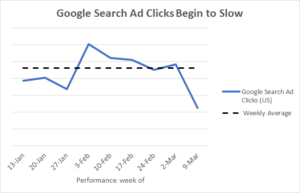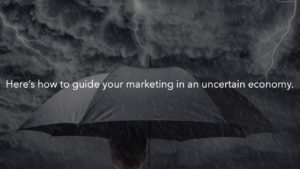4min. Read
Everyday business executives ask me, “How do I navigate this chaos and market my products so I can keep paying my people?”. My team and I at ID have found paths through the market madness that are working for us and our clients and I’m going to share several of those paths with you now. With some minor tweaks, you can tailor them to fit your specific brand/business needs. My hope is that by sharing these with you you’re able to keep your business moving forward and your teams employed. I also hope this inspires you to pay it forward by helping other businesses anyway you can. We all need to help each other out, do what we can and keep people employed so they can care for their families.
Mobile Campaigns:
With more consumers sheltering in place and working from home they are less reliant on their mobile devices. Consequently, mobile search traffic has declined significantly, down over 25% versus pre-Covid-19.

Since mobile traffic is generally cheaper for PPC (pay per click), this shift has meaningful implications for your PPC strategy. To adjust to the current reality, we suggest reducing mobile campaigns and moving some of those dollars to video and streaming channels (see below for why we’ve moved budget to video). If you’re using a lot of mobile marketing, you’ll also want to consider:
Source: WordStream
#1 Revisiting device bid adjustments
Previously you might have set a mobile bid adjustment using historical data but given the current fast changes in the search landscape, we suggest revisiting your current device-level bids.
#2 Smart bidding
At ID we’re selective about when we use automated bidding. It doesn’t always generate the ROAS or other results the platform vendor (mostly Google) promises. However, with search behavior shifting so dramatically its worth taking a look at Google’s smart bidding strategies. We see initial signs that, during these rapidly changing markets, it’s helpful digesting changing data and adjusting CPC bids in real-time. If you choose to go this route remember that setting clear goals and close budget management are still keys to your success.
New Customers Beyond Google SERP
While consumers are spending less time in brick & mortar stores and less time on Google search their internet use is up nearly 50% since the beginning of the pandemic. And while Google search and shopping traffic is down there are still plenty of other options outside of Google’s SERP (search engine results page). Look at it like this, it’s easier to find new customers now because more people are spending more time online. Plus, with Google search and shopping losing some of their strongholds on consumers your marketing teams can tap into new sources of customers. Here are some specifics things to do…
#3 Search & Display
BING: Move some/more of your search budget to Bing. Too often dismissed by marketers, Bing still makes up roughly 1/3 of the US market share. In addition to its 5 billion searches a month, Bing’s users aren’t exclusively searching on Bing. Over 100 million searchers rely on both Bing and Google so what they find on Bing may impact what, and/or who, they search for on Google. According to WordStream, businesses that advertise on Bing not only reach potential new customers searching on Bing, but they will also see, on average, a 26% increase in searches for their brand on Google! Bing also has advantages over Google of being cheaper, providing more device control and enabling more granular campaign control.
GDN: The Google display network (GDN) is also now more influential than pre-pandemic. As shown below, GDN traffic is up 13% since the beginning of March. While an average display CTR (click-thru rate) of 0.35% is OK (search CTR is ~3.71%) the fact that we see a +30% average increase in brand searches on Google after launching the first display campaign, and more traffic, has us moving more resources into GDN.
#4 Quick Tip – Search Partners
Include Google search partners in your campaigns. Check the “Include Google search partners” box in the networks tab of your campaign settings and then segment your data by “Network (with search partners.)” to see individual performance.
#5 Retargeting
Another key action to take away from this is to increase your retargeting. With more people spending more time online, and the increase in display network traffic, it’s prime time to bring your visitors back to your site so move some of that mobile budget to your retargeting efforts. Repeat visitors convert better and they often have a better CPA (cost per acquisition).
Video and Streaming (incl. music)
Take note of the 21% increase in YouTube ad traffic in the previous chart. Layer on top of that the fact that subscriptions for streaming TV and video jumped 32% the week of March 16 alone according to Recurly Inc., and it becomes clear where you need to be–promoting on streaming and other video-based channels.
#6 Video
Building on the insights above…You can also see below the increase in traffic Netflix and YouTube are experiencing. This isn’t new news however, the reduction of in-app traffic isn’t talked about which goes back to the reduction in mobile use. To make sure you are where your audience most likely is we suggest increasing your YouTube promotions and unique content generation. Also, consider running UGC (user-generated content) promotions now. Consumers have more time to participate so the quality of the content you will likely be better.
When it comes to choosing what content types/publications to refocus your budget on, consider this–according to GlobalWebIndex, 38% of consumers say they are reading more online news and 36% are watching more linear (versus online) TV content as a result of the coronavirus. Plus, 27% are spending longer on social media. We don’t know how long these new habits are going to last (we’re betting at least 3-6 months) but we have taken an even more aggressive real-time approach to media use–making more rapid adjustments. Where it makes sense, we’ve increased spend on news publications, social media (especially FB for driving ecommerce and Amazon sales) and traditional TV commercials.
Note: We’re cautioning against shooting new TV/video spots promoting the “we are here for you/pull together” type messages. The market is saturated with them and we feel they are starting to come off as disingenuous. If our client wants to go in that direction we’re making sure that the ads have a specific way or action that describes “how” the brand is there for consumers in relation to the conditions caused by the virus.
If you have a youth brand you need to be on TikTok.
One of the newer video channels in North America is TikTok. If you have a brand that skews younger (41 percent of TikTok users are aged between 16 and 24; 56% are male) you need to be on TikTok, especially now. According to Music Business Worldwide, the week of March 16th the video app was downloaded 2 million times (an 18% increase in downloads from the previous week). The app also saw a 27% increase in the first 23 days of March compared to February with 6.2 million downloads.
As for Quibi – not sure yet. Because consumers have reduced mobile use and are watching binge-watching more long-form content, we’re being cautious with the service. We’re experimenting and gathering our insights as we speak (more to come on this in a later article).
#7 Music
When it comes to promoting on music streaming services, we’ve traditionally had good results with Spotify for several of our clients. However, we’re seeing those results weakening. Variety reported a ~7.6% drop in plays. Here’s why it’s happening. A recent Nielsen Music / MRC Data report says that 49% of respondents said they are spending less time with music because they are driving or commuting less, while 47% are listening to less music because they’re spending more time with other forms of entertainment – of those people, 73% cited news, 71% books and magazines; 65% films and 64% television.
If you are spending on music streaming promotions, we suggest watching it carefully and, if you see what we’re seeing, do like we are doing and reallocate a reasonable portion of that budget to video and display. If you stay with streaming music promotions, know that more acoustic, lower-energy, as well as more instrumental music, news, kids programming and cooking programs, have increased. “Danceable” music has decreased.
Analytics & Research
#8 Avoid Being Tone-Def:
Consider increasing your remote creative pretesting. With the message hypersensitivity we’re seeing in the market we are being cautious about how our campaigns are being perceived tonally. One misstep and your brand could suffer lasting damage. For new creative, pretesting has become even more important than pre-COVID-19 because it continues to be a reliable predictor of in-market performance. In some cases, we’ve retested pre-COVID-19 creative to make sure it is still effective and relevant. You don’t have to make this a big study, just do some quick “sanity” checks with your creative.
#9 Short-term KPIs/Metrics
We’re coaching our clients to “quarantine” short-term KPIs (key performance indicators) and metrics. In other words, don’t put as much faith in those measures because many of them represent extreme-case reactions from the market. We’re recommending that we limit the application of the short-term KPIs and metrics to inventory replenishment and other more tactical uses versus using them for long-term creative/marketing planning.
Bonus: Matched Market Tests
Because comparing consumer behavior in a test region with cconsumer behaviorin a control region requires stability, we’ve postponed all of this testing. As social distancing mandates change, they destabilize the areas being researched and makes any insights questionable. Unfortunately, we’ve had to do the same with ROPO (research online, purchase offline) for the same reasons. We suggest taking this budget and making those analytics systems/team improvements you’ve been trying to get to.
If you have team members that have lessened workloads redeploy them on a needed strategic and roadmap planning.
Double Bonus: Time to Think
Pausing a lot of the things you usually do means that you may have something you usually find in short supply: time to think. This could be the perfect time to invest in post-coronavirus action planning, product/service planning, upgrading your analytics strategies for 2021 and beyond. None of us knows what life, and marketing, will look like on the other side of the coronavirus but for now, we can try to figure out what our best practices, guidelines, and guardrails for measurement should be in the future. If you have team members that have lessened workloads redeploy them on a needed strategic and roadmap planning.
Conclusion
I hope that what I shared with you here helps keep your business moving forward and your people employed. If I or my team can help in any other way, please reach out to us but most of all I ask that you look for ways to pay it forward.
Be healthy, smart and safe.




